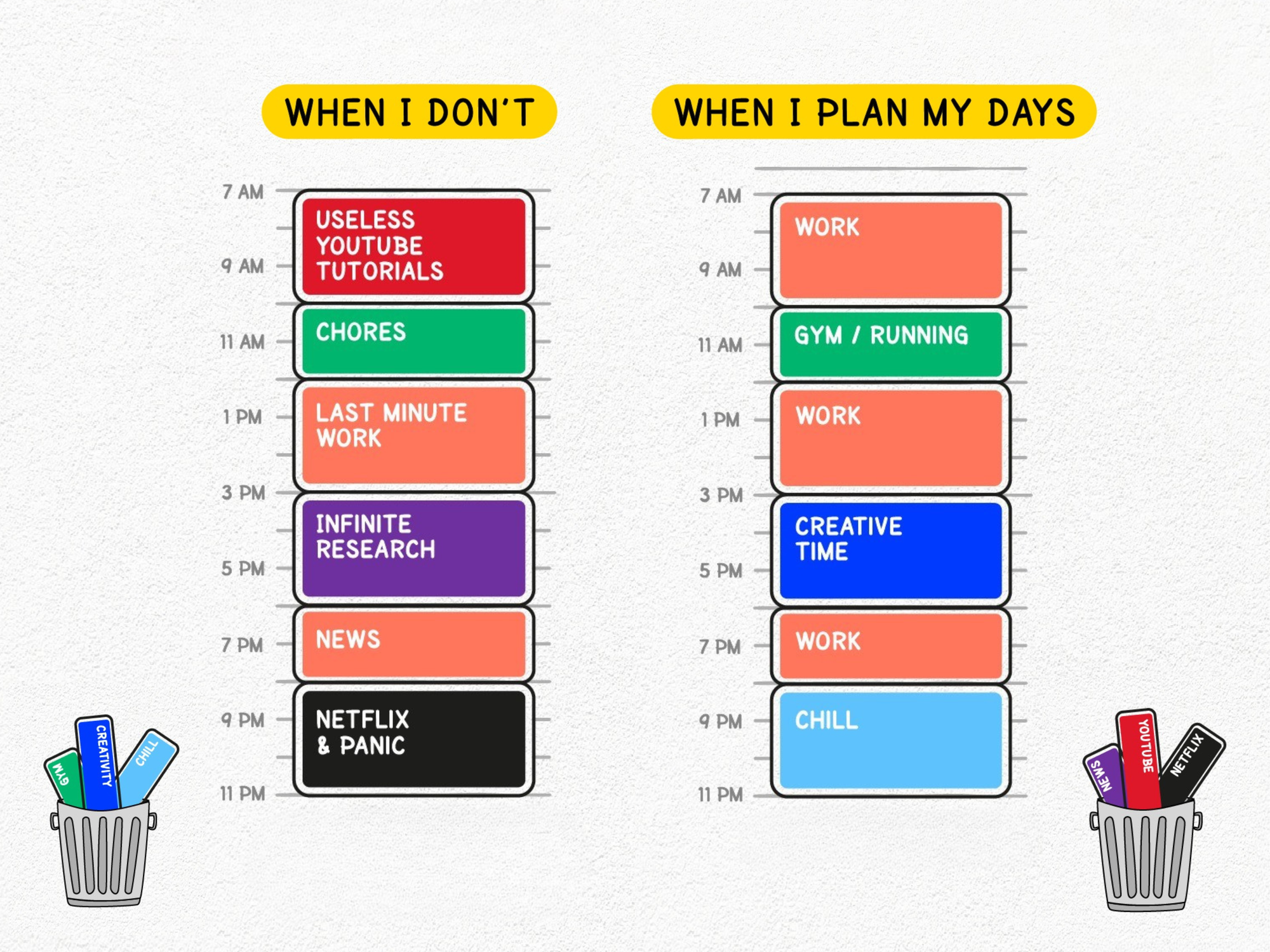April 20, 2025 | #36 | read on The Happier Studio | Free Version
Welcome to The Happier Newsletter, a weekly newsletter where I provide actionable ideas to help you build a happier, healthier, and more meaningful life.
What’s On Today
- 8 Steps to Designing a Life You Want
- Exercise: Design Your Day
8 Steps to Designing a Life You Want

Most people don’t design their life. They drift into it.
They say yes to the job offer because it’s there. They follow the path that seems “right” because it’s familiar. They do what’s expected. And years later, they look around and quietly ask themselves: “How did I end up here?”
They feel stuck, not because they’re broken, but because they never paused to ask what they actually wanted.
But what if you approached your life like a designer? What if you could shape it the way an architect shapes a building, layer by layer, sketch by sketch, based on what matters most to you?
That’s the idea behind Designing Your Life by Bill Burnett and Dave Evans, a book that reframes how we think about purpose, careers, and what it means to live well.
It outlines a powerful process, one that can help you move from drifting… to designing.
Let’s walk through it.
1. Reframe How You Think About Life & Work
Many of us grow up with a fixed idea of success: Pick one career. Climb the ladder. Stick with it. Retire.
But real life is rarely that linear. There’s no single “right” path. There are likely multiple different lives you could live that would bring you joy, meaning, and fulfillment.
The pressure to figure it all out from the start is not only unrealistic, it’s unnecessary. You’re allowed to change directions. To try something new. To evolve.
- Your job title isn’t your identity.
- Your value isn’t measured by your income.
The most fulfilled people didn’t land on the perfect plan at age 22. They experimented. They made mistakes. They paid attention to what mattered. And they adjusted, again and again, until their life started to feel right.
What truly defines your life is how you spend your time, and whether it aligns with who you’re becoming.
You just need to start designing with intention.
2. Track What Energises You
Every day, you experience moments of energy and moments of drain. The key to designing your life? Pay attention.
- What activities make you lose track of time?
- What projects excite you?
- What drains you, even if you're “good” at it?
Your energy is a compass. The more you follow what energises you, the closer you get to a life you love.
3. Prototype Your Future
Most people try to think their way into a better life. The problem? Thinking isn’t enough.
- Want to switch careers? Don't quit everything, freelance, volunteer, shadow someone first.
- Thinking about moving? Spend a few weeks in that city.
- Considering a big lifestyle change? Try a short version first.
Small experiments = better decisions.
You don’t need a perfect plan, you need a prototype.
4. Build Multiple Life Plans
Most people have one idea of what their future should look like. And if that plan falls apart? They panic.
The solution: create three different life plans.
- Plan A: Keep doing what you’re doing
- Plan B: Make a big change
- Plan C: If money, fear, or expectations didn’t matter, what would you pursue?
Seeing your future as a menu rather than a single path opens up possibility. You realise you’re not stuck. You have options. And options create power.
5. Get Unstuck with Brainstorming & Reframing
Feeling stuck? The problem isn’t you, it’s how you’re thinking.
- Shift from “What’s the best decision?” → “What are my best options?”
- Move from “I don’t know what to do” → “I’ll explore different paths.”
The best solutions come from taking action.
Instead of waiting for the “right” answer, start exploring.
6. Focus on Action, Not Just Reflection
Reflection is helpful. But reflection without action becomes rumination.
Most people wait to feel ready. They overthink. They procrastinate. They journal and journal, hoping clarity will strike.
But clarity comes from doing.
- Apply for the job.
- Take the course.
- Reach out to the person.
The faster you take small steps, the faster you figure out what works. So stop waiting, start building.
7. Find Your People
Success isn’t a solo game. Your network isn’t just about job opportunities. It’s about mentorship, inspiration, and collaboration.
- Talk to people who have the life you want.
- Ask how they got there.
- Surround yourself with people who challenge and support you.
The fastest way to grow is to learn from those ahead of you.
8. Iterate & Evolve Constantly
Here’s the thing no one tells you: A well-designed life isn’t a final product. It’s a work in progress.
You’ll change. Your values will shift. Your goals will evolve.
That’s not failure. That’s growth.
So keep experimenting. Stay flexible. Let go of the need to “get it right” and focus on making it yours.
Because the happiest, most fulfilled people? They’re not the ones who had it all figured out. They’re the ones who kept designing.
🎯 Design Your Day

A well-designed life starts with a well-designed day.
If you don’t plan your time, the internet will plan it for you. Social media, emails, and endless distractions will quietly eat away your hours.
So instead of drifting through your days, design them intentionally.
Here’s how:
Step 1: Envision Your Ideal Day
Start by asking yourself: What does a good day look like for me?
How do you want to feel throughout the day, energised, calm, focused? What do you want to accomplish? Not just tasks, but also how you want to show up.
Think about when you want to do things too. Are you better at deep work in the morning? Do you prefer calls in the afternoon? Map it out.
Step 2: Choose What Matters Most
Pick the three things that matter most today.
These could be meaningful tasks, important moments, or simple habits that align with the life you want to build. When you define what matters, you reduce overwhelm and increase focus.
Step 3: Block Your Time Intentionally
Now, sketch a simple structure for your day. You don’t need to plan every minute, just give your time a purpose.
- Morning: Deep work, movement, or creative time
- Midday: Admin, calls, or a walk
- Afternoon: Focused tasks, errands, or meetings
- Evening: Rest, connection, or learning
Adjust this to suit your lifestyle.
Step 4: Set One “Anti-Distraction” Rule
Choose one rule to protect your focus.
Maybe it’s no social media until 2 PM. Maybe it’s keeping your phone in another room while you work. Or simply turning off notifications.
Even one small boundary can dramatically improve your attention.
Step 5: Reflect Briefly Before Bed
At the end of the day, take a moment to check in:
- What gave you energy today?
- What drained it?
- What would you change or keep for tomorrow?
These small reflections help you notice patterns, make better decisions, and keep evolving.
